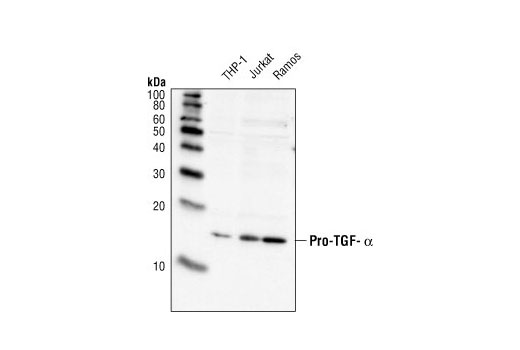WB
H M
Endogenous
17
Rabbit
#P01135
7039
Product Information
Product Usage Information
| Application | Dilution |
|---|---|
| Western Blotting | 1:1000 |
Storage
Specificity / Sensitivity
Species Reactivity:
Human, Mouse
Species predicted to react based on 100% sequence homology
The antigen sequence used to produce this antibody shares
100% sequence homology with the species listed here, but
reactivity has not been tested or confirmed to work by CST.
Use of this product with these species is not covered under
our
Product Performance Guarantee.
Rat
Source / Purification
Polyclonal antibodies are produced by immunizing animals with a synthetic peptide corresponding to the amino-terminal sequence of TGF-alpha . Antibodies are purified by protein A and peptide affinity chromatography.
Background
Transforming growth factor alpha (TGF-alpha) is a member of the epidermal growth factor (EGF) family, sharing the same receptor, EGFR, and regulating cell proliferation, survival, and differentiation (1). Members of the family share an EGF-like domain of 45-60 amino acids characterized by the conservation of six regularly spaced cysteines, forming three disulfide bonds that function as their receptor binding domain. TGF-alpha was initially discovered in the media of retrovirally transformed fibroblasts, and its name comes from its ability to induce transformation in cultured fibroblasts (2). This transforming activity was later shown to require TGF-beta, which potentiates the activity of TGF-alpha through a separate receptor (3). Soluble TGF-alpha is released from its membrane-bound precursor, pro-TGF-alpha, following protolytic cleavage, but the membrane bound precursor is still able to bind and activate EGFR (4). Binding of soluble or membrane bound TGF-alpha to EGFR leads to receptor dimerization, tyrosine autophosphorylation, and activation of downstream signaling components. TGF-alpha and related peptides play an important role in the progression of cancer as well as in neuropathological processes (5,6).
- Derynck, R. (1986) J Cell Biochem 32, 293-304.
- de Larco, J.E. and Todaro, G.J. (1978) Proc Natl Acad Sci U S A 75, 4001-5.
- Roberts, A.B. et al. (1981) Proc Natl Acad Sci U S A 78, 5339-43.
- Wong, S.T. et al. (1989) Cell 56, 495-506.
- Rusch, V. et al. (1996) Cytokine Growth Factor Rev 7, 133-41.
- Junier, M.P. (2000) Prog Neurobiol 62, 443-73.
Species Reactivity
Species reactivity is determined by testing in at least one approved application (e.g., western blot).
Western Blot Buffer
IMPORTANT: For western blots, incubate membrane with diluted primary antibody in 5% w/v BSA, 1X TBS, 0.1% Tween® 20 at 4°C with gentle shaking, overnight.
Applications Key
WB: Western Blotting
Cross-Reactivity Key
H: human M: mouse R: rat Hm: hamster Mk: monkey Vir: virus Mi: mink C: chicken Dm: D. melanogaster X: Xenopus Z: zebrafish B: bovine Dg: dog Pg: pig Sc: S. cerevisiae Ce: C. elegans Hr: horse GP: Guinea Pig Rab: rabbit All: all species expected
Trademarks and Patents
Limited Uses
Except as otherwise expressly agreed in a writing signed by a legally authorized representative of CST, the following terms apply to Products provided by CST, its affiliates or its distributors. Any Customer's terms and conditions that are in addition to, or different from, those contained herein, unless separately accepted in writing by a legally authorized representative of CST, are rejected and are of no force or effect.
Products are labeled with For Research Use Only or a similar labeling statement and have not been approved, cleared, or licensed by the FDA or other regulatory foreign or domestic entity, for any purpose. Customer shall not use any Product for any diagnostic or therapeutic purpose, or otherwise in any manner that conflicts with its labeling statement. Products sold or licensed by CST are provided for Customer as the end-user and solely for research and development uses. Any use of Product for diagnostic, prophylactic or therapeutic purposes, or any purchase of Product for resale (alone or as a component) or other commercial purpose, requires a separate license from CST. Customer shall (a) not sell, license, loan, donate or otherwise transfer or make available any Product to any third party, whether alone or in combination with other materials, or use the Products to manufacture any commercial products, (b) not copy, modify, reverse engineer, decompile, disassemble or otherwise attempt to discover the underlying structure or technology of the Products, or use the Products for the purpose of developing any products or services that would compete with CST products or services, (c) not alter or remove from the Products any trademarks, trade names, logos, patent or copyright notices or markings, (d) use the Products solely in accordance with CST Product Terms of Sale and any applicable documentation, and (e) comply with any license, terms of service or similar agreement with respect to any third party products or services used by Customer in connection with the Products.
